Most Valuable Translator Awards – 2022
We hope that you are all well and have had a wonderful start to 2023! A lot has happened in the past year, but our linguists have continued to provide excellent work for us. They respond in timely manners, produce high-quality translations, and are always kind! It is truly a pleasure to work with them all.
In order to show our appreciation for our linguists, each January we like to announce our Most Valuable Translator Awards. Translators who are given this accolade are those who have repeatedly gone the extra mile and who have helped us when we have needed them most. It of course goes without saying that we are incredibly grateful for all of our freelance translators’ help and so it is difficult to choose only 15. Everyone works so hard and is a pleasure to work with, so thank you to you all!
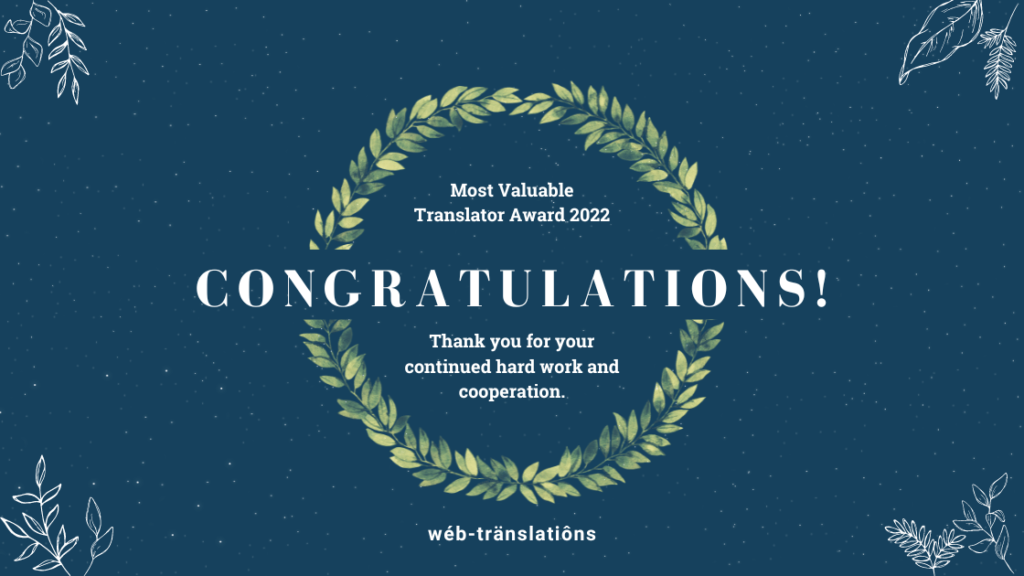
However, the Web-Translations team have been particularly impressed by the below group of linguists; some have provided invaluable assistance on urgent projects, while others have consistently provided high-quality contributions for our key client accounts. Their professionalism, communication and translation talent is second to none and does not go unnoticed.
Please join us in congratulating the following 15 linguists (listed in alphabetical order):
- Axel Couton
- Betty Revelioti
- Christina Pauly
- Gizem Kartum
- Hussam Muhidat
- Ingrid Devanne
- Isabella Marzano
- Laura Mussutto
- Maciej Glinksi
- Marco Ramon
- Octavian Blenchea
- Pablo Montero Llano
- Thomas Carlsen
- Yoshi Shiomitsu
- Zlatka Gospodinova
Thank you from the bottom of our hearts! We look forward to working with you, and all of our fantastic linguists, throughout the next year! See you next January for the next Most Valuable Translator Awards.
Love,
Web-Translations
Christmas Films from Around the World
What’s your favourite Christmas film of all time? Struggling to think of just one? Well, that’s understandable! There are so many classic Christmas films that we can’t blame you for not being able to pick just one. After all, at Web-Translations, we certainly can’t!
Have you ever thought however that it might be time to mix it up a bit and find a new film that warms the cockles of your heart and makes you feel all fuzzy inside? Obviously these new films will never replace the classics you grew up with, but you might still love them nevertheless. And you never know, they may just become the classics of your future!
To give you some inspiration on where to begin, we’ve collated some of our favourite Christmas films from across the globe. Hopefully some of these will jingle their way into your hearts!
1. Noche de reyes (Spanish)
Directed by Miguel Bardem, this 2001 Christmas comedy is pure, light-hearted entertainment. It’s perfect for those who like hilarious comedies in which chaos and unfortunate events make your stomach hurt from laughing. It centres upon the adventures of the Cuspineda family whose father is going to sign a very important contract on Twelfth Night. In order to reach this contract however, it seems that everything is going to stand in their way. It’s utterly ridiculous and utterly marvellous.

2. Les bronzés font du ski (French)
We’ve all heard of National Lampoon’s Christmas Vacation. It’s a classic, that’s a fact. Have you ever heard of Les bronzés font du ski however? If you’re not French, then you probably haven’t but you should certainly change that! This 1972 comedy directed by Patrice Leconte is the French equivalent of National Lampoon’s Christmas Vacation and despite not being a hit when it was first released, it is now regarded as France’s eighth favourite film.
The film centres upon a group of friends who go on a skiing vacation in the French Alps. The film will make you laugh out loud as the protagonists run into a multitude of unfortunate mishaps. You are sure to soon regard it as one of your favourites!
3. 大停電の夜に (Japanese)
The third festive film we’d like to share with you is a Japanese film called Until the Lights Come Back. Evocative of films such as Love Actually in which the stories of multiple characters weave in and out, our third film centres upon the premise of what happens when the lights go out in Tokyo on Christmas Eve. It is simple, heart-warming and magical, and you will be sure to feel all festive inside after watching it!

4. Klaus (Spanish-American)
Our next festive pick is a Spanish-American animated family film directed by Sergio Pablos. The heart-warming tale offers an alternate origin story for Santa Claus and centres upon Jesper, a selfish postman who is forced to move to grey and gloomy town called Smeerensburg. Eventually teaming up with an isolated toy maker Klaus however, Jesper is able to spread joy to the faraway town, teaching that even the smallest act of kindness can spark another.
5. Malous Jul (Danish)
The final Christmas film we’d like to share with you is a Danish film directed by Claus Bjerre. The film centres upon a girl named Malou who, after living with several foster families ends up on the small island of Lunø with a family who loves Christmas. Malou is not so fond of the holiday however, so when she meets a grumpy elf who wants her to leave, they decide to cause as much trouble as possible to help her do so. Funny, magical and perfectly festive, you’re bound to love Malou’s Christmas.
These are just some of our favourite Christmas movies, we’d love to hear your favourites though! Be sure to get in touch on social media and share the festive cheer.
How to Make Translation Easy | Everything We’ve Learnt
It’s been over a year since Client Services Manager Lauren and Translation Project Manager Charlotte joined the Web-Translations team, and what a year it’s been!
From exciting new projects to flashy new web designs, there’s little they haven’t done in the last year and of course, they’ve learnt so much! That’s why in this blog post we’re handing the girls the reigns and letting them share their knowledge. So, if you fancy learning some top tips on how to ensure a smooth translation project! This is just the right blog for you!
1. Preparation is Key

Charlotte: The first thing that I think everyone needs to know in order to ensure a smooth translation process is that, no matter how tight a deadline may feel, there is always time to prepare a project properly. What is more it’s vital!
Lauren: Yes! I agree! When the client comes to us with readily finalised content, this saves time in the long run as it means that we can avoid any possible changes further down the line.
Charlotte: It helps everyone really. If your content is clear and concise from the get-go, it means that our linguists will have a better idea of what you want to say from the off! This saves time going back and forth asking questions and it also saves money.
Lauren: Exactly! After all, when you’re paying for translation on a per word rate, you want to make sure that those words are the right ones and aren’t unnecessary.
2. Know Your Audience
Lauren: Another key point to consider to allow for a smooth translation process is the language variant you’re translating into. For example, if you’re wanting to target Canada, then you’d need to use French for Canada instead of French for France.

Charlotte: That’s a really good point and I think it’s also important to know whether you would like your translation to have a formal or an informal tone. Likewise, it’s good to know if you want your translation to be more creative or be more loyal to the source text.
Lauren: In general, the better idea you have of who your audience are, the better tailored your translations will be to achieve your desired aims.
3. Communication – The Hidden Gem
Charlotte: The next point may sound obvious but it’s actually something that can really affect the translation process and that’s communication. Quite simply, if you don’t communicate something to us, then we’re not going to know it!
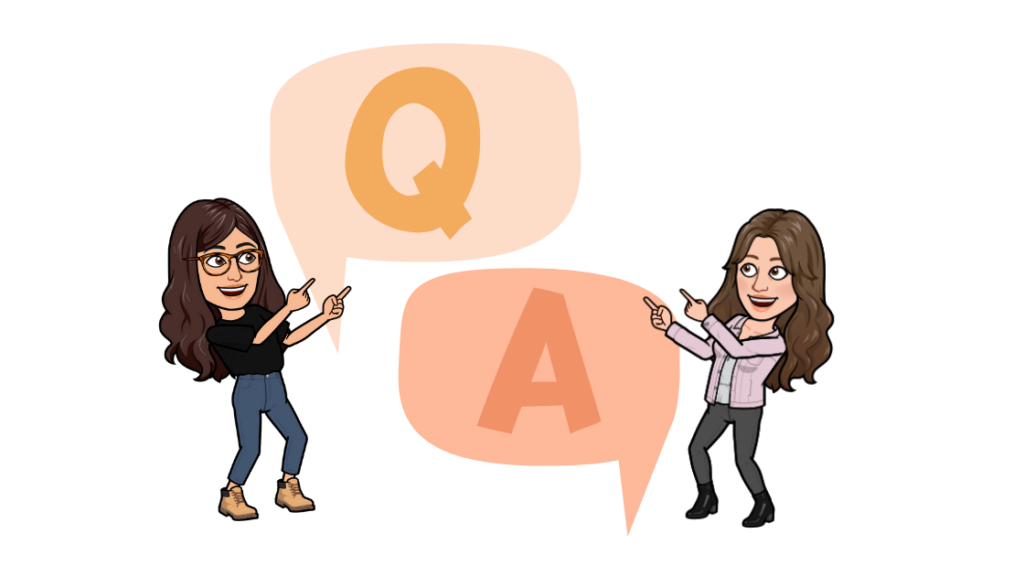
Lauren: That’s actually a really good point! For example, if you don’t tell us how you’d like us to deliver your translation, then we won’t know how to. On the other hand, if you’re unsure on what file to send us in the first place, just ask! We’re always happy to answer any questions.
4. Understand our Services
Lauren: Although our name suggests that our services end with translation, there’s actually lots more that we offer. For example, don’t forget that our standard translation package actually includes proofreading by a second native linguist.

Charlotte: Yes, and then on top of that we can offer typesetting, in-situ QA checks and so much more! It’s also a good idea to get in touch with us to see if there’s anything else we can help out with. You never know, we might be able to lighten your load ever so slightly.
Lauren: You’d be surprised what we can do!
5. Setbacks are Part of the Process
Charlotte: Our final piece of advice to help ensure a smooth translation process is quite simple: just breathe and everything will be okay!
Lauren: If you follow our advice and clearly outline your text and target audience at the beginning and clearly communicate with us along the way, everything will work out just fine.
Charlotte: And even if setbacks do arise, there is always a solution for everything. For example, if there is a delay at your end in acquiring a file, just let us know and we can easily adapt on our end to accommodate for the new timeframe.
Lauren: Definitely! That’s no problem at all! Likewise, if there are obstacles during the project at our end, we’ll always let you know as soon as possible to mitigate any delays and any unnecessary stress.

Charlotte: Sometimes projects can be quite stressful despite all best efforts! For these situations we highly recommend that you get yourself a furry friend to cuddle up to and take away the chaos for a bit!
Lauren: Pets really are the best work companions 😊
We hope these tips have been useful and they have helped you get a better idea of how to ensure a smooth translation process! Be sure to follow us on social media for all things translation!
Equally, if you fancy reading more of our translation advice, why not check out some of our other blog posts such as our recent article on Website Localisation.
Autumn Terms from Around the World
Autumn is finally here and we are living for the pumpkin spiced lattes, shorter days and cosy sweaters! Yes, it’s the time of year when we can take life at a quieter pace and enjoy the beauty of the small things before the mayhem of Christmas kicks into action.
To celebrate Autumn and all the beauty it brings, we thought we’d share some of our favourite autumnal words from around the world! Words that make are hearts warm upon hearing them and our souls smile upon saying them.
So, get ready to get cosy as we present the snuggest, most homely and heart warming words!
1. Złota Polska Jesień
Złota Polska Jesień is a Polish term which means a ‘golden Polish autumn’. Approximately 30% of Poland’s land is covered by forests which means that, during autumn, approximately 30% of Poland is decorated in gorgeous golden-red tones. Now that’s something we want to see!
2. Lloviznar
Lloviznar is a Spanish word which means ‘to drizzle.’

Whilst we are big fans of autumn you can’t deny that it does bring a lot of rain.
However, although the rain itself isn’t the prettiest of sights, ‘lloviznar’ certainly has an endearing sound to it! It comes from the verb ‘llover’ which means to rain, which ultimately derives from the latin ‘plovere’.
3. Conkers
Any British reader will know what a conker is and any British reader should equally testify that this is a great word to say! For those who aren’t aware, a conker is a chestnut and the word comes from a game that dates back to the 19th century.
The game is relatively simple yet addictive. First you need to drill a hole in a conker and thread a shoelace or a piece of string through it. Next, you need to tie a knot at each end to secure the conker. And finally, you take turns trying to hit each other’s conker until one breaks. And voilá – simple yet mountains of fun!
4. Zucca
Zucca is an Italian noun and it is another word which is pleasing to say! Further still it is arguably the most synonymous term with autumn. Any thoughts of what it might mean?

… It’s a pumpkin of course!
Is it truly autumn if you haven’t carved a pumpkin for Halloween, made a pumpkin pie or drunk a pumpkin spiced latte? We vote no!
5. Les Feuilles
Les feuilles is a French noun which means ‘leaves’. The term is rather unexciting in English but it sounds rather pretty in French, don’t you think?
6. Calavera
Calavera is a Spanish word which means ‘skull’. However, in Mexico, this term has a lot more to offer than simply a black and white skull. Yes, during el Dia de los Muertos, there is nothing more iconic than a colourful calavera! They can be made of sugar or clay and are decorated with flowers, beads and icing.

Both adorning ofrendas and decorating the streets, calaveras are the heart of autumn in Mexico.
7. Herbstlaubtrittvergnügen
Our final term is a lovely long German word which describes the ‘pleasure of kicking through autumn leaves’ – a pleasure which I think we all share! The term is a combination of four words. First up there is ‘herbst’ which means ‘autumn’. Next we have ‘laub’ which means leaves, ‘tritt’ which means ‘kick’ and ‘vergnügen’ which means ‘pleasure’. It’s quite straightforward when you break it down like that I suppose!
We hope you have enjoyed learning about our favourite autumnal words! We’d love to hear some of your favourites though! Why not get in touch via our social media to share your thoughts!
Fancy reading more about words in translation? Why not check out last years blog post exploring some of our favourite untranslatable words?
Back-to-School Refresh: International Marketing
In our final blog post in our back-to-school series, we’re talking about international marketing. Whilst many of you will know the best way to communicate with your clients in your own language, there are several points that you will specifically need to consider when talking to your international audience.
Whether it be by considering the specific language variant of your target audience or carefully planning the timing of your content, the trick is to make your customer feel seen.
After all, we all like to feel valued at the end of the day!

To help ensure that your international content has been designed to do just that, Web-Translations has put together a short video guide on our top tips for international marketing!
So, sit back, relax, and enjoy our whistle-stop overview of international marketing strategies.
We hope you have found this useful! We have of course only scratched the surface though! If you’d like to learn more about how to target your international customer, please get in touch. Why not also check out our Spring Towards Your Target Market blog post?
To stay up to date with all things Web-Translations and our other Back-to-School Refresh blog posts, be sure to follow us on social media!
Back-to-School Refresh: Subtitles
As part of our back-to-school refresh blog series, today’s blog will be going over some subtitle guidelines and why they are necessary. Despite playing an important role, guidelines do make subtitling that bit more difficult. This is why subtitling is such an art, and why a machine can’t produce the same high-quality subtitles that a professional human linguist can.
This blog will delve into some of the guidelines a little deeper and help to clarify what role they play in the quality of subtitles. Let’s get straight to it:
Syncing subtitles
It’s important to try and sync the subtitles to the visuals and the audio as best as possible. This is much easier said then done, however. By syncing the subtitles with the video, they will appear when the character’s lips are moving for example. This makes them feel more natural. The subtitles should also be in sync with the audio as much as possible too. Despite not necessarily understanding the audio, this will help the viewer read the subtitles.
Enough time to read
It is recommended that the subtitle should appear on screen for between one and seven seconds. This allows enough time for the viewer to read the subtitle. The time will depend on the subtitle’s CPS (characters per second).

The recommended figure is around 17 CPS, as this is based on the average reading speed.
Consider the visuals
For Latin alphabet languages, it’s advised that the character limit per line is 42. On top of this, a subtitle is recommended to have no more than 2 lines. This may not sound so bad, but for languages such as German for example where the words are considerably longer than English, this can be quite the challenge. So why are these guidelines necessary? It restricts the subtitle, to avoid it covering too much of the visuals.
On-Screen text
If there is text superimposed on the video, this is known as ‘on-screen text’. Common examples of this are ‘two years later…’ or maybe interviewee names. This can be subtitled, above or below the original text, however this covers more of the video. Alternatively, if the text was added as editable text, this could be changed on the video itself.

This decision would of course depend on the budget, as the first option is considerably cheaper than the latter.
Keep Subtitles Clear
Due to the restricted time and space with subtitles, it’s important to keep them clear and concise. Removing any unnecessary hesitations could help achieve this. Although it’s always worth considering whether the hesitation has an intended effect or not.
Time to Breathe
There is also a guideline which advises that there should be at least 2 frames between each subtitle. Around 24 frames are drawn each second, so this really is a very short gap. It may seem insignificant; however this gap allows our brains to refresh and acknowledge the new subtitle effectively.
Positioning
Where we position subtitles is also key. The positioning must remain as consistent as possible. Subtitles can be moved to the top of the screen, so that it doesn’t interfere with the visuals.

However, you should try to avoid going from the top to the bottom and back to the top where possible.
This is because it makes it difficult for the viewer to follow the subtitles. If you need to change the location, extend the subtitle length so that the viewer can catch up.
We hope you have found this useful! We have of course only scratched the surface though! If you’d like to learn more about subtitling, please get in touch and we’d happily talk to you about subtitling your content.
To stay up to date with all things Web-Translations and our other Back-to-School Refresh blog posts, be sure to follow us on social media!
Women in Translation Month
Ice creams, picnics and sandcastles. Three things which are synonymous with August. But did you know that in the translation industry there is something else which is a pretty big deal? … Women in Translation Month!!
Set up in 2014 by a blogger name Meytal Radzinski, Women in Translation Month initially sought to address the gender imbalance in translated literature. The initiative has now grown into an annual celebration of female authors and we wanted to join the celebration by collating a few of our favourite female translators from the past!
1. Constance Garnett (1861-1946)
First up is Constance Garnett, a Russian to English translator. Her translations include works by Tolstoy, Dostoevsky and Chekhov. Garnett translated 71 volumes of Russian literature and her translations were fundamental in shaping our understanding of Russian history and culture. After all, War and Peace is a pretty big classic don’t you think?

2. Claudine Picardet (1735-1820)
Second on our list is Claudine Picardet. Picardet was a scientific translator who translated from Italian, German, English and even Swedish into French! Also a chemist, mineralogist and a meteorologist, Picardet was an incredibly intelligent woman. Her most important translations were a set of chemical essays by Karl Scheele (a Swedish chemist who helped discover oxygen – you heard right, oxygen!) Through her translations, she contributed greatly to the spread of scientific knowledge during the chemical revolution.
3. Margaret Tyler (1540-1590)
Next up is Margaret Tyler. Tyler is a Spanish to English translator who became the first Englishwoman to translate a Spanish romance book. Furthermore, she became the first woman to publish a romance book in England. The work she translated was ‘Mirror of Princely Deeds and Knighthood’ by Diego Ortúñez de Calahorra.
In the sixteenth century, ‘masculine’ and ‘secular’ topics were considered inappropriate for women to translate. Tyler however protested against this. She believed that both men and women deserved to be treated as equals.

4. Giuseppa Barbapiccola (1702-1740)
The fourth translator we’d like to celebrate is Giuseppa Barbapiccola. Barbapiccola was an Italian philosopher and poet who translated from Latin and French into Italian. She advocated for women’s education and in 1722 published her seminal translation ‘Principles of Philosophy’ by René Descartes. With this text, she desired to educate women and praise the female intellect. And for that, we applaud her!
5. Matilda Hays (1820-1897)
Finally, our last linguist is Matilda Hays. As well as a journalist, novelist and feminist, Hays was a French to English translator. As one of the first openly gay women, Hays and her friend Elizabeth A. Ashurst became the first translators of George Sand’s work. They translated texts such as ‘Spiridion’ and ‘Letters of a Traveller’. Hays wanted to use her writing to improve the condition of women and so she co-founded the monthly ‘English Woman’s Journal’ in 1858.
These are just five women who made a mark in the translation world. However, we’d love to hear about your favourite female translators! Get in touch via social media!
Fancy reading more about Women in Translation month? Why not head over to last year’s blog on the topic? There, we explore our favourite novels by women in translation!
Lifting the Lid on Subtitling Templates
Need your video to be available in multiple languages? Want to show your customers that you invest in them? Don’t fret, at Web-Translations, we are able to add multilingual subtitles to your video content but can reduce turnaround time and cost. For more information on our subtitling service, take a look at our recent blog.
Subtitling for multiple languages can be time-consuming and the cost can add up. However, we can use templates to help save you time and money. Read on to find out more about Subtitling Templates.
What is a Subtitling Template?
Subtitling templates are the transcription of a video’s dialogue and on-screen text. This is done in the language of the video, also known as the source language. But why do need this you may be asking? Why can’t the video just be translated straight into the target languages? Well, when a video is being subtitled the audio needs to be transcribed to create a script. Using this script, the linguists can then add timecodes to each phrase. They also ensure that the timing of the subtitle is aligned with both the video and audio. The linguists can then move onto translating the script, and make any tweaks to the timings. This depends on how the language has expanded or contracted.
Types of templates
Templates can be either locked or unlocked. Locked templates mean that the subtitler cannot amend the timecodes and will just translate the subtitles. This allows for a quicker turnaround, as the linguists won’t need to spend time adjusting the in and out times. Unlocked templates, however, provide the linguist with a base, but allows them to amend the subtitles accordingly.
There are also another two types of template: original language and pivot language. This depends on the language of the video. Original language templates are a time-coded intralingual transcription which is then translated into the target languages. Pivot language templates, however, are a time-coded transcription in a third language. This third language is typically English, and it serves as an intermediary between the source and target languages. For example, if you have a video in Malay, it may be difficult to find linguists to translate into French and Spanish. However, by using a pivot language template, you can have one linguist translating the Malay into English. Then you have linguists translate the template from English into French and Spanish. This is particularly useful for those less common languages.
Although pivot templates mean that less common language videos can be accessible to a wider audience, aspects of the original culture could be lost. After all, the English to French translator may not understand Malay. But this is where annotations come in. A native speaker of the source language creates these annotations. They may note cultural references, the meaning of shortened words, cases of wordplay, puns and jokes. But they may also highlight the use of slang, tone of voice and meaningful names. These annotations mean that the translated subtitles are as close to the original as possible.

Why is Using a Subtitling Template Beneficial?
By creating a template, there are various advantages. We’ve listed some of these below:
- The subtitling process is more efficient, as the video is only transcribed once. This means that the turnaround times are reduced, and you save time.
- The content is standardised across all languages within the project. Therefore each set of subtitles will be consistent.
- As you only need to pay for one template to be created, rather than transcriptions for each language, this allows for a reduced cost, saving you money.
- Quality is assured across all languages, as a native speaker of the original language creates the template. This means that the transcription would be accurate.
- A template also ensures cultural and linguistic accuracy. The native linguist is aware of cultural references. For example, meaningful names, certain monuments, and particular food that is eaten at a certain time.
We hope this blog answers any questions about Subtitling Templates. If you do have any other questions, please get in touch via our contact page or social media.
Fancy learning more about the world of translation? Why not check out our blog lifting the lid on Proofreading?
The Wonderful World of Words
Déjà vu … Doppelganger … Cliché…
We all know what these words mean. They’re pretty common terms that appear in English speech on a regular basis. In fact, they’re so ingrained in the English language that they appear in the Oxford English Dictionary. And rightly so.
But, did you know that these terms aren’t actually English? They’re actually French, German and French again. They have simply been adopted into the English language, perhaps because of their perfect meaning or perhaps because of the way they sound. After all, you have to admit that ‘doppelganger’ is a great word to say!
There are lots of words which come from different cultures, and we could spend an eon talking about all of our favourite loan words. But we’re sure you’ll have already heard of these! Instead of telling you what you already know, therefore, we wanted to talk to you about some of our favourite words in translation that haven’t been embedded into the everyday English language yet, but certainly should be!
So, ready to learn some fantastic words? Well then, vámonos…
1. L’esprit de l’escalier
L’esprit de l’escalier is a French term used to encapsulate that feeling of thinking of the perfect reply too late. It literally means ‘staircase wit’ and it is certainly something we’ve all experienced at some point in our lives.
So, the next time you think of the perfect way to finish an argument or the perfect punch line to end your joke when lying in bed days after an event, remember this term and at least you’ll have the perfect way to describe why you’re frustrated!
2. Pana Po’o
Our next term is … wait… let me think (*scratch head to remember*)…. Pana Po’o!!!
Pana Po’o is a Hawaiian term to refer to the action of scratching one’s head in order to remember something. It’s quite a specific term, but we’re sure you all do it!

3. Tartle
Tartle is a Scottish word that not only sounds amazing but also has the best meaning. It’s a term to describe the hesitation you feel in the split second before introducing someone. The hesitation in which you realise you’ve forgotten their name!! It’s a heart stopping moment we can all agree!
4. Gigil
Imagine the scene: you’re walking down the street and you see a little puppy jumping in muddy puddles with some tiny wellington boots on. Pretty cute right? So cute that you might want to go up to the puppy and cuddle it? Well, gigil would be the word to describe this feeling.
Gigil is a Tagalog term which describes the overwhelming feeling that comes over us when we see something cute and potentially want to go squeeze it.

5. Aspaldiko
Our final word is a term that many of us will have experienced in recent months. It’s a Basque term that describes a joyous reunion. In other words, it embodies the euphoric feeling experienced when catching up with an old acquaintance.
We hope you have enjoyed learning some of our favourite words in translation and we hope you start to use these in your day-to-day lives!
If you fancy learning more fantastic words, be sure to follow us on twitter and keep up to date with our word of the week series. Or if you’d rather read another blog, maybe our International Translation Day blog post is a good place to start? There’s lots more to learn!
National Crime Reading Month | Crime Fiction in Translation
June is #NationalCrimeReadingMonth in the UK. It is a festival run by the Crime Writers’ Association in partnership with The Reading Agency. The celebration is a time to promote and celebrate crime reading, and we wanted to participate in such a celebration by exploring some of our favourite crime fiction novels in translation.
Yes! We all know that we Brits love a good detective novel. In fact, in recent years, we have even witnessed a boom in the sales of crime fiction. However, what you may not know is that crime fiction makes up a large degree of the sales of translated works. Consequently, many of the crime novels we read are in fact translations, we just don’t always realise it!!
That’s why in this blog post we wanted to celebrate these translated novels and their translators.

So, sit back, relax and join us in celebrating some fantastic stories and fantastic individuals.
1. Don Bartlett and Jo Nesbo’s Harry Hole Series
The first crime fiction novels we’d like to celebrate are Jo Nesbo’s Harry Hole thrillers. Set in Oslo and featuring the uncompromising, chain-smoking and impossible Harry Hole as it’s protagonist, Nesbo’s novels are amongst the bestselling crime novels in the world and are well worth a read.
The translator bringing the first 10 of these Norwegian masterpieces across the ocean to our bookshelves is Don Bartlett. Bartlett has translated some of the most talked about Norwegian books in recent years. Furthermore, he has won awards such as the American Academy of Arts and Letters and has been nominated for prizes such as the International Manbooker Prize in 2017. Quite simply, Bartlett is an exceptional translator without whom Nesbo’s works simply wouldn’t be the same.
2. Laurie Thompson and Henning Mankell’s Kurt Wallander Series
Moreover, in keeping with the theme of Nordic noir, the second novels we’d like to celebrate are Henning Mankell’s Kurt Wallander works. Set in Sweden, Mankell’s stories explore both a multitude of bloody cases as well as underlying xenophobia.

His work has been sold worldwide and adapted multiple times. One adaptation was even brought to life by Kenneth Branagh and Tom Hiddleston!
The translator responsible for the English editions of Mankell’s work is Laurie Thompson. Thompson is a prolific literary translator who also lived a distinguished academic career. He published well over fifty titles and we should all applaud his work as Mankell’s translator.
3. Louise Heal Kawai and Seishi Yokomizo’s Detective Kosuke Kindaichi Series
Seishi Yokomizo was one of Japan’s most prolific and beloved mystery writers. He is best known for his Kosuke Kindaichi series. The series includes 77 titles and its stories have been adapted to both television and stage within Japan. Featuring novels such as The Honjin Murders – one of Japan’s greatest murder mysteries of all time – this is a series you must read!
Currently, only 4 books from this series are available in translation but the translator bringing these titles to an English-speaking audience is Louise Heal Kawai. She has translated Japanese literature since 2005 and has translated many journals and scripts as well as novels.
4. Frank Wynne and Pierre Lemaitre’s Camille Verhœven Series
The fourth series of crime novels we’d like to celebrate are Pierre Lemaitre’s Camille Verhœven Series. Consisting of three titles, the series follow the short and yet pugnacious Commandent Camille Verhœven of the Paris Police force. Fast paced and full of twists, the novels are certain to pull you in and leave you wanting more.

What is more, with all three being shortlisted for the CWA International Dagger Award and two winning the prestigious award, one cannot deny that the series is a masterpiece.
Frank Wynne is the individual who brought these novels across the pond and is a translator of an exceptional calibre. He is a two-time winner of both the Scott Moncrieff Prize and Premio Valle Inclán. Even more impressively, he also became the Chair of the judging panel of the 2022 International Booker Prize. (The first translator to ever chair the panel!)
5. Rachel Ward and Simone Buchholz’ Chastity Riley Series
Finally, our last set of translated crime novels are Simone Buchholz’ Chastity Riley Series. The German novels centring upon the hard-bitten, Hamburg born state prosecutor are fresh and fast-paced. Moreover, with plenty of wit to accompany Buchholz’ dark storytelling, you are bound to be entertained by this series.
Bringing the fizzling dialogue of these modern noirs to an English audience is Rachel Ward. Ward is a freelance translator of literary and creative texts from German and French to English. Ward’s translations are seamless. Furthermore, conserving the nuances, lyricism and sensations within Buchholz’ writing, Ward’s translations play an integral role in assisting the series’ popularity.
Ultimately, these are just a few of our favourite crime novels in translation. We’d love to hear your favourite novels and their translators though! Get in touch via social media.
Fancy reading more about literature in translation? Why not check out our women in translation blog post?
Lifting the Lid on Translation and Localisation
It is likely that you have heard the terms ‘translation’ and ‘localisation’. They are fairly common terms, and they are often used interchangeably by brands wishing to expand their services overseas.
However, did you know that they actually refer to different services?
It is true that both wield the shared aim of adapting your brand’s content into a new language to reach a new audience. However, there is a fundamental difference between them:
With translation, it is the meaning of a text which gets transferred. With localisation, it is the experience.
In this blog, we’re going to delve further into the differences between translation and localisation. But if you’re still unsure on anything after reading, please don’t hesitate to get in touch!
Translation as the Starting Point
Translation is the process of rendering text from one language into another so that meaning is equivalent. It is often thought as the first step within localisation as it converts the written words from one language into another and thus enables a piece of text to be read by a new audience.
However, to be ‘read’ by a new audience is as far as translation gets. Although sentence structure and grammar are of course adjusted within translation, it is important for translators to stay true to the original text. This means that any cultural referents specific to the source country held within the source text will be translated faithfully with no adaptation.

Now, you may be thinking that such a fidelity is a good thing. And if you are, you wouldn’t be wrong! It is great to respect the author’s intentions, and in a literary or even technical text, we’re all for it!
The problem is that, within marketing texts, such a loyal translation may decrease engagement with your desired audience.
For example, if you’re selling a sports drink which claims to make you feel like Harry Kane, you have to ask yourself whether retaining the name Harry Kane in your Italian marketing campaign would have the same effect as it would in your English. After all, we’re not so sure Italian kids would want to feel like Harry Kane. Surely they would rather feel like Ciro Immobile?
Translation therefore has certain limitations. This is where localisation comes into play.
Delving Deeper with Localisation
Once a translation has been provided, localisation delves deeper. Addressing cultural and visual components as well as linguistic issues, localisation helps you relocate your product to a new country. In other words, it enables your desired audience to feel like your document is made for them.
But, how does this work in practice? Aside from cultural references such as football players, there are several elements which localisation can influence.
Numeric Differences.
When localising your text, you need to ensure that all measurements, dates and currencies conform to that which are used in your target market.
For example, if you’re targeting Spain, you’d need to use euros rather than pounds. This conversion of currency would be an example of localisation.

Visual Considerations.
Before commencing your overseas campaign, you need to ensure that all images work in the context of the target culture.
For example, whilst a bacon bap may be an enticing image for a British audience, this would unlikely be the case for an Arabic-speaking audience. This is because, in many Arab countries, pork is a forbidden food. Advertising including such an image therefore might be disrespectful. Localisation would consequently alter this image.
Formatting Differences.
If you are localising your text, you will also need to think about the layout of your content. If your advert were in Arabic for example, you would need to flip it so that both the writing and visual content read right to left.
Furthermore, if the language were to use a non-Roman script such as Japanese, it would probably be good for you to alter the font size and type. This will help your customer read it clearly. These little stylistic differences are all examples of localisation.

Why is Localisation Important?
In a nutshell, localisation is what makes your marketing campaign work. It is what adapts your brand to the cultural elements of your target audience. It is what makes your customers connect to a brand. Quite simply, if you wish to provide an equal experience for all, localisation is the way forward.
Have more questions about localisation that you’d like answering? Feel free to get in touch via our social media or drop us an email. We’re always more than happy to help!
Interested in learning more about the translation industry and its terminology? Why not check out our Lifting the Lid on Translation and Interpreting blog post?
Let’s Bring Cannes Film Festival to You!
This week is the 75th Cannes Film Festival, an annual event which previews new films of all genres. The festival’s purpose is to draw attention to film, celebrating cinema at an international level.
Composed of films from all over the world, it is a truly international festival which as a language agency, is something that we love!
In honour of such an occasion we wanted to help bring the Cannes Film Festival to you! That’s why we’ve collated a list of some of our favourite international films.

So, whack out your fanciest frock, bust out the popcorn and get ready to commence your very own Cannes Film Festival!
1. Ochos Apellidos Vascos
Released in 2014 and directed by Emilio Martínez-Lázaro, Ochos Apellidos Vascos is one of the best Spanish comedies out there. Within six weeks of its release, it became the second biggest box office hit ever in Spain. Pretty impressive don’t you think?
Known as ‘Spanish Affair’ in English, the story centres upon Rafa and Amaia. The former is a proud Andalucian who has never left his native Seville and the latter is an equally proud girl from the Basque Country. Having discovered that Amaia left her purse in Seville following a night out with her friends, Rafa decides to pursue Amaia to her native Basque Country to return her belongings.
However, as a series of misunderstandings unfurl, Rafa is forced to feign a Basque identity, concocting an elaborate series of eight Basque surnames – hence the film’s literal English title: ‘Eight Basque Surnames’. As he becomes more and more entangled in his lies, a film of comedic farce ensues which is thoroughly entertaining.

Funny, light-hearted, and endearing, you’re bound to laugh with this film.
2. 기생충
Our second movie recommendation is the South Korean film Parasite. Not merely did this win the Palme d’Or at the 2019 Cannes Film Festival, but it also won the Academy Award for Best Picture. It became the first non-English language film to win such an accolade.
Labelled as both a black comedy and psychological thriller, Parasite follows the poor Kim family who scheme to become employed by the wealthy Park family. Infiltrating their household by posing as highly qualified individuals, greed and class discrimination soon come to the fore and threaten the seemingly symbiotic relationship.
It’s perhaps a little darker than our previous pick. But if you’re looking for a film to sink your teeth into, this is certainly the one to watch!
3. El laberinto del fauno
It is unlikely that you’ve never heard of our next choice. Released in 2006 and directed by Guillermo del Toro, El laberinto del fauno (Pans Labyrinth in English) is a critically acclaimed Mexican film that premiered at the 59th Cannes Film Festival.
Exploring both a magical realist world as well as the horrors of Falangist Spain, El laberinto del fauno centres upon an 11-year-old girl named Ofelia. Ofelia travels with her pregnant mother to the countryside. Here she meets her new stepfather, a sadistic captain of the Spanish army.
Furthermore, upon arrival, she meets a faun in the centre of a labyrinth. A faun that informs her that she is a princess. Tasked to prove her royalty by performing three tasks, Ofelia enters a world of mythical beings that albeit frightening, bears little to the sadistic horrors taking place outside of the magical realm.

Del Toro’s work won a multitude of international awards including three Academy Awards. It is magical, distressing, and yet enticing. It is simply a film you must watch.
4. Les Choristes
Known as The Choir in English, Les Choristes is a 2004 French musical drama directed by Christophe Barratier.
The film centres upon a French boarding school in the late 1940s. Although its students and teachers are constantly at odds, everything changes with the arrival of a music teacher, Clément Mathieu. Starting a choir, Clément attempts to change the school’s reactionary policies. He particularly impacts a young boy named Pierre, someone who shows great musical promise.
Full of whit, drama, and stunning original music, you are bound to be encaptivated by Barratier’s work.
5. La vita é bella
La vita é bella (Life is Beautiful) is a 1997 Italian comedy drama directed by Roberto Benigni. The film is one of the highest grossing non-English language films of all time. It won the Grand Prix at the 1998 Cannes Film Festival.
The film centres upon Guido Orefice, a Jewish Italian bookshop owner who utilises his prolific imagination to protect his son from the reality of internment within a concentration camp. Inspired by the novel, In the End, I Beat Hitler, the film wields elements typical of both soul-stirring romantic comedies and grittier historical genres.
It is truly stunning. Upon watching the masterpiece, you will laugh, and you will cry. You will hate and you will love. La vita é bella is a film which sticks with you and rightly so. Its origins in history make the film tug at your heart strings more so than most, but despite the sorrow, one cannot deny that it truly makes you believe that life is beautiful.

What is more it makes your heart forever warm upon hearing the infamous words ‘Buongiorno Principessa’. It may make it ache a little too, but it will warm, nonetheless.
These are just a few of our favourite international films. We’d love to hear your top picks, however! Get in touch via social media to share your favourite foreign language films!
International Marketing | A Focus on Your Customer’s Wellbeing
It is no secret that the online world of social media and marketing can often present a picturesque veneer of an idyllic universe. A universe in which we all have our affairs in order and look picture perfect at any given moment.
Whilst this world can at times provide a welcome escape from the monotony of daily life, it can also isolate many. What is more, this isolation is exacerbated by the fact that the picture-perfect world is often singular, representing one standard of beauty, one version of culture, one language of communication.
The consequence of such a singular marketing strategy is that many feel left out. This both can then negatively influence your prospective customer’s mental health and furthermore reduce engagement with your brand. Quite simply, it’s a lose-lose situation.
This is where localised marketing comes into play. It is common knowledge, that if you want your business to succeed, you need to consider your Ideal Client Profile. But how do you actually talk to your specific client and how do you make them listen?
In this blog, we at Web-Translations are going to provide you with some tips to make sure you’re localising your content the right way. So, get your pen and paper and get ready to start jotting!
1. Language
It may seem like an obvious starting point, but if you’re planning to target the individual customer, you need to do so in their own language. For example, if you’d like to target a Chilean customer, you can’t simply translate your content into ‘Spanish’. You need to ensure that your content is professionally localised into Chilean Spanish.
This is because certain vocabulary has different meanings depending on the country in which it is spoken. For example, whilst ‘guagua’ means ‘baby’ in Chile, it means ‘bus’ in Puerto Rico. Quite different you have to admit!

Although these differences can be comical, they immediately illustrate to the customer that they are not the priority audience. In other words, they immediately suggest that the business doesn’t care about them.
This can then increase the likelihood of a disconnect arising between customer and advert. Research is vital to ensure you’re translating into the right language for your audience. If you need guidance, we would be happy to advise!
2. Content
It is not uncommon for adverts to include cultural references within their content. In likening their product to something associated with a celebrity, many brands may increase their appeal.

For example, if a musician were to liken their new album to the sound of Take That in the 90’s, many British customers would likely be excited at the prospect.
The same might not be said however for a German audience. After all, they’re probably not as up to date with Take That’s greatest hits as we are!
It might be a good idea therefore to domesticate this reference. In other words, it might be a good idea to replace the comparison to Take That to a German band that has a similar sound. (Maybe Scooter would be a good option…?) Your customer still may not recognise the band, but they are more likely to recognise something from their own culture than another’s.
3. Aesthetic
Furthermore, the images used within your marketing campaign should be relevant to your specific audience. For example, if you’re selling a baked good which has a unique selling point of making you feel at home, you might want your image to reflect your target audience’s home and not the source country’s home.

It’s not rocket science, but you might be surprised by how much of a difference it makes.
4. Music
Music is integral to any marketing campaign. Establishing the mood of the video, music has the potential to instantaneously unlock your desired emotion in your customer.

Although it’s often the melody that triggers a reaction, the lyrics may also play a fundamental role.
When adapting your content for each target market therefore, it might be a good idea to think about altering the audio. Whether you substitute the English lyrics for Polish or replace the English song for a Polish song for example, time should be taken to ensure your specific audience is being catered to.
5. Timing
Lastly, our final aspect to consider is time. Across the globe, there are more than 24 different time zones. When planning your social media campaign, these time zones need to be respected. For example, if you’re a British company trying to branch into Mexico, tweeting at 9am GMT is futile. Whilst 9am is a great time of day to tweet, the same cannot be said for 3am in Mexico City.

When planning your social media campaign, therefore, take a moment to reflect upon the time zone of your target market.
After all, if you’re trying to target your customer directly, you don’t want there to be a 6 -hour delay between publication and reception! It may make your customer feel a little bit like an afterthought!
As we’ve established, therefore, it isn’t simply the case that one piece of content suits all. The language, content, aesthetic, music and timing of your content are all variables that should be adjusted and localised to your individual customer.
At the end of the day, it’s simple: people like to feel valued. If your marketing strategy can achieve such a goal, then not merely will you reap greater rewards, but you might just make people happier too!
We hope you’ve enjoyed reading this blog. If you’d like some more tips on reaching your ICP, why not check out our Spring Towards your Target Market blog post. Equally, if you’d like to read more blogs from our Mental Health series, why not start with our Mindfulness in Translation blog post?
Mindfulness in Translation
“There is virtue in work and there is virtue in rest. Use both and overlook neither.”
The fast-paced nature of the modern world can often mean that it is easy to get swept away by the hustle and bustle. Consequently, you would not be alone if you felt like it was necessary to work every waking minute and repeatedly push yourself to achieve your greatest potential.
Whilst there is undeniably something to be said for wielding an unwavering work ethic and caring about your career progression, it is also important that you take a moment to breath.
This is why at Web-Translations we wanted to help. In this blog, we’re going to share some of our favourite books in translation that explore all things mindfulness.

So, sit back with a nice cup of tea, grab your favourite biscuits and enjoy a moment of quiet. After all, you deserve it!
1. Ikigai: The Japanese secret to a long and happy life by Héctor Garcia and Francesc Miralles
Our first recommendation of mindfulness in translation is a Spanish novel which was translated into English by Heather Cleary.
‘Ikigai’ is the Japanese word to mean a ‘reason to live’. It is the place where desires and ambitions meet. This book helps you find your own Ikigai, equipping you with the ways in which you can change your life and make each day joyful.
As an international bestseller, it is spell bounding and a novel that you must read.
2. The Things You Can See Only When You Slow Down: How to be Calm in a Busy World by Haemin Sunim
Our second choice of recommended reading is a Korean novel translated into English by Haemin Sunim and Chi-Young Kim.
Haemin Sunim is a Buddhist monk who was born in Korea and educated in the United States. In this book, Sunim reminds us of the beauty which can be found in slowing down. He offers advice on how to approach setbacks and how to manage relationships.
Selling over three million copies around the world, it is not hard to see the novel’s popularity and with simplistic messages and stunning illustrations, it is not hard to see why it is so popular.

3. Handmade: Learning the Art of Chainsaw Mindfulness in a Norwegian Wood by Siri Helle
Our third choice of translated literature is slightly different from our other picks. Written in Norwegian by Siri Helle and translated into English by Lucy Moffatt and Kari Dickson, Handmade follows the autobiographical story of Siri Helle who, after inheriting a small cabin, decided to build an outhouse for herself.
Handmade celebrates the notion of making something with your own two hands. It perhaps doesn’t teach you the practice of mindfulness but, through humour and insight, it teaches you the power that comes with crafting.
4. I Have More Souls Than One by Fernando Pessoa
Next up on our list of mindful reading is a Portuguese poetry collection. Translated into English by Jonathan Griffin, I Have More Souls Than One contains poems written by four distinct personae. Each follow a mind tormented by suffering and a mind that journeys on an endless search for meaning.
With many of the poems covering merely a single page, it is the perfect book to dip in and out of and take your time to process each and every masterful stanza. Dramatic and lyrical, you’re bound to love it.
5. You Are Here: Discovering the Magic of the Present Moment by Thich Naht Hanh
Our final recommendation of mindfulness in translation is a French novel translated into English by Sherab Chodzin Kohn.
In this book, the author simplistically explores the heart of Buddhist thinking. As a Vietnamese monk and meditation master, Thich Nhat Hanh’s teachings are powerful and thought provoking. His work will empower you to witness the wonder of life and stay within the present moment.
Explained in simple prose, Thich Naht Hanh’s work is perfect to begin your mindful journey.
We hope you’ve enjoyed taking a moment to read our mindful recommendations. If you’d like to continue with the mindful theme, why not check out our other blogs in honour of #MentalHealthAwarenessWeek?
Equally if you fancy hearing more recommendations of literature in translation, why not check out our Valentines day blog?
Lifting the Lid on Desktop Publishing
Do you need to translate PDFs, brochures, or other carefully designed content? And have you considered that the layout of these translations may need to change slightly in order to accommodate longer texts, or right-to-left languages?
There’s no need to worry, as we offer a desktop publishing service that will help. Read on to find out how we can help you create perfectly localised materials for print or download.
What is Desktop Publishing?
If you haven’t heard of the term desktop publishing before, you may have heard it referred to as typesetting or DTP. This process involves using design software, such as InDesign, to create files with customisable layouts for print or download.
Simply translating an IDML file export won’t mean that your translated file is ready for printing right away. A specialist designer needs to import the translated file into InDesign, and make any changes. These changes can include:
- Lengthening text boxes
- Changing font sizes
- Tweaking elements
- Adding line breaks
- Formatting embedded graphics
The aim of this process is to make the translated file look as good as the original, whilst avoiding the ‘this has been translated’ look.
The Process
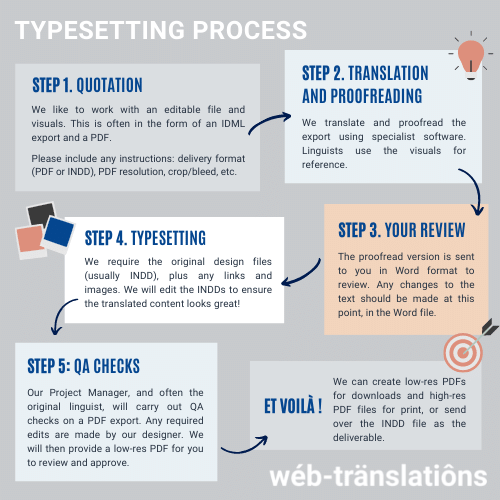
Why use Web-Translations?
Text could expand or contract by around 25% once it has been translated. This may cause some issues when trying to retain the original file’s formatting and layout. If you haven’t planned for this in advance, our designer may need to reduce a font size or increase the size of a text box, for example.
Non-Latin alphabets can also be difficult to work with for the uninitiated. One example of this is Arabic, which reads from right to left. This means that the entire page layout needs to be reversed. As most designers don’t have experience with translation and probably don’t speak the language of the target text, it can be difficult for them to rework the layout and format of the translation. In fact, some designers may even introduce errors to the translated content, as they are not translators themselves. At Web-Translations, however, we could save your designer’s both time and effort, as we have the skill to adjust the formatting and page layout of your translations ready for print.
Our experienced typesetters can tackle anything from business cards to technical manuals, and from packaging to posters, so it’s safe to say that your content is in good hands. But if you’re in the process of designing new marketing collateral for translation, check out our blog post on translating PDFs for some pointers.
Differences Between Languages
As we mentioned earlier, texts can become considerably shorter or longer during the translation process, as each language has its own structure and set of characteristics. Below we’ve provided a few examples of how much some languages can expand or contract when translating from English:
| Language | Average Expansion/ Contraction |
|---|---|
| French | 20% longer |
| German | 20% longer |
| Korean | 10% shorter |
| Swedish | 10% shorter |
| Arabic | 25% longer |
| Spanish | 20-30% longer |
| Finnish | 30% shorter |
| Norwegian | 15% shorter |
We hope these figures give you a better idea of the differences between the languages, and that you’ll be able to bear this in mind when creating your carefully designed documents.
To find out more about our language solutions, please visit our Services page. Or, if you’d like to talk to us directly, why don’t you fill in our contact form? We’re more than happy to help.
Spring Towards your Target Market
With lighter days and daffodils blooming, it is clear that spring is well and truly upon us. And with that, it may be time to have a little sort out!
Yes, spring is the perfect time to refresh, saying goodbye to former, ineffectual habits and hello to revitalised, propitious behaviours. Such changes may take place within your personal life, but such a spring clean can also be carried out within your business.
This is why, at Web-Translations, we wanted to help. Although we may not be able to advise on finance or product creation, we can certainly assist you with the marketing of international campaigns. As such, in this blog, we’re going to go back to basics and explore the five key points to consider when branching out into international trade.

1. Language
It may sound like an obvious starting point, but if you’re planning to target international markets, then it’s important you do so in your target market’s language. Not merely does this illustrate respect to your customer, but it may also increase conversions. This is because online customers are statistically more likely to buy from a website in their own language. For example, a study found that 40% of internet users stated that they would never buy from websites outside their native language. What is more, 65% of people would rather look up content in their native language.
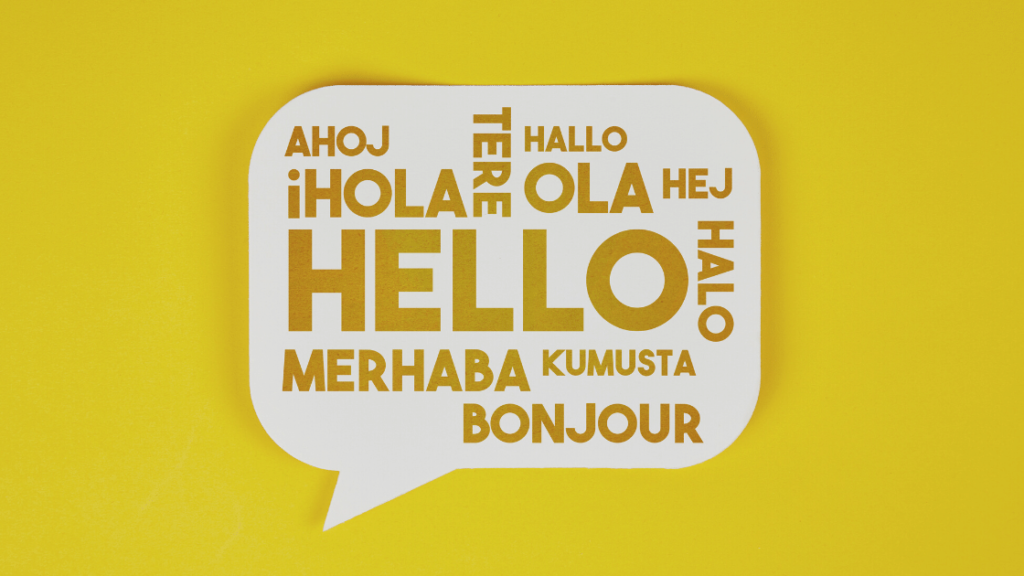
Making an effort to localise your content yields benefits. However, if you’re going to localise, you need to do it right.
In other words, if you’d like to expand into Argentina, it isn’t simply sufficient to get your website translated into ‘Spanish’. You need to ensure that your site is professionally localised into Argentinian Spanish. Furthermore, if you’d like to branch into the Canadian market, you can’t simply reuse your French for France content. You’d need your content localised into Canadian French.
See the pattern? Research is vital to ensure you’re translating into the right language for your target market. If you need guidance, we would be happy to advise.
2. Time Difference
Nowadays, it is taken as a given that any successful company will have a thriving social media presence. Whether it be via Twitter, LinkedIn or Instagram, a global presence is key. However, it isn’t simply the case that one tweet suits all.
Across the globe, there are more than 24 different time zones. Consequently, when planning your social media campaign, these time zones need to be respected. For example, if you’re a British company trying to branch into Mexico, tweeting at 9 am GMT is futile. Whilst 9 am is a great time of day to tweet to achieve maximum outreach, the same cannot be said for 3 am in Mexico City.
When planning your social media campaign, therefore, take a moment to reflect upon the time zone of your target market.
3. Seasonal Difference
Heralding in longer days and warmer climates, March in the Northern Hemisphere signals the start of spring. As such, many businesses move away from the snowy and cosy advertising of winter and shift towards the bright and pastel tones of spring.

However, if you’re targeting international markets, it may be worth holding back on such advertising. Whilst spring may be in vogue in the Northern Hemisphere, the same cannot be said for the Southern Hemisphere. Similar to how time varies in different countries, climate varies too. You should thus consider this when launching any global campaigns.
4. Cultural Difference
Every corner of the world has its own set of cultural traditions that are unique to them. It’s what makes the world a beautiful and vibrant place. However, within these cultures there are sensitivities that need to be respected.
For instance, whilst an image of a sausage sandwich may be enticing to a British audience, this would unlikely be the case for an Arabic-speaking audience. This is because, in many Arab countries, pork is a forbidden food. Any advertising including such meat therefore may not only be fruitless, but it could be disrespectful.
Consequently, when engaging in international trade, an awareness of cultural traditions and sensitivities are essential.
5. Local Competition
Finally, when journeying into international waters, it is important that you know your local competition.
By knowing what your target market currently has to offer, you will be able to ascertain the correct marketing approach. For example, it would be futile advertising a building block related toy as revolutionary and unseen in Billund, Denmark – the home of Lego. Perhaps it would be better to present it with a new twist, building upon an aspect that Lego doesn’t provide… We’re not sure what that could be, but it could be anything!! The world’s your oyster!
When expanding into international markets the basics to consider are: Language, Time, Climate, Culture and Competition.
We hope this blog has helped you go back to basics and encouraged you to have a bit of a spring clean. After all, it is that time of year! Or at least it is for us in the North!
Any other tips you fancy sharing? Get in touch via our social media channels!
Lifting the Lid on Machine Translation Post-Editing
If you’ve used Google Translate, then you would have already used Machine Translation. But you may have also noticed some of the embarrassing blunders that the machine makes. This is why we offer Machine Translation Post-Editing (MTPE).
MTPE is a low-cost translation solution. It allows translations to be generated quickly at a lower cost through the use of machine translation. However, it also uses the human post-editor to put the text into context and helps the translation to sound natural.
What is the MTPE process, and how is it different to other Machine Translation services?
Once we have received the original file, we put it into our industry-leading machine translation software. This software generates a quick and raw translation in the chosen languages. We then send this output to our professional linguists for review. The linguist will correct any errors, improve its readability and adjust the tone and style to meet the client’s needs.
Unlike other machine translation providers, our machine translation software is secure and confidential, ensuring that your content is safe. We can also integrate any existing translations or preferred terminology that your business may have. This means that your translations are consistent and tailored to your brand.
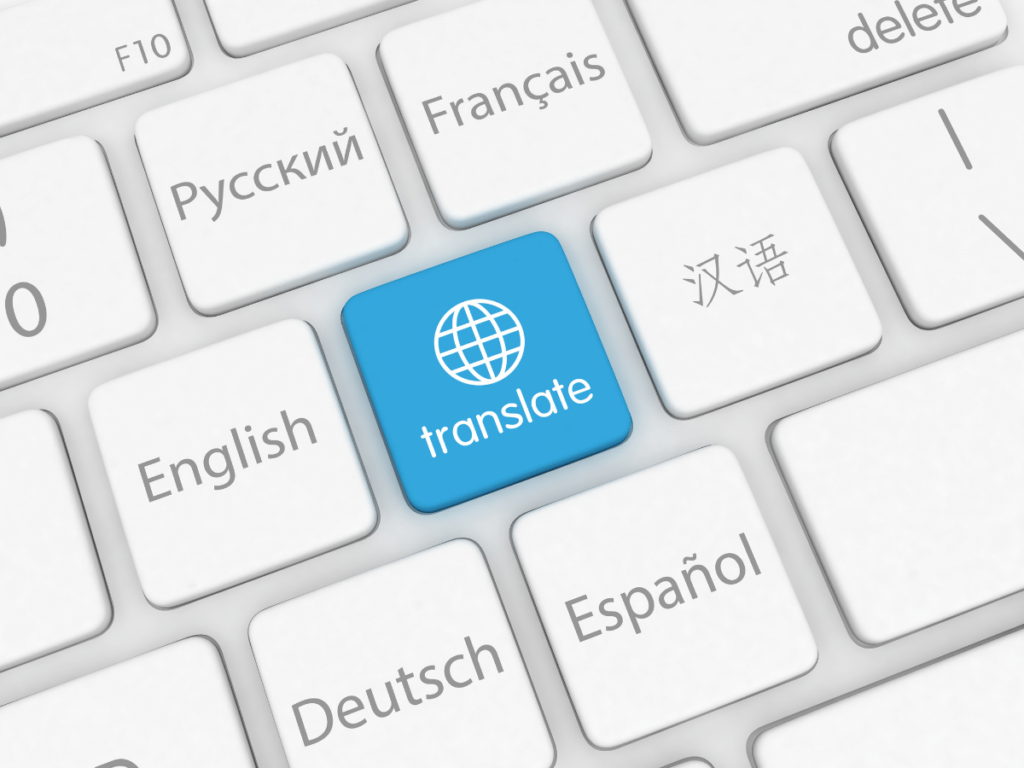
MTPE is a low-budget and quick solution for your translation needs.
Is MTPE appropriate for all types of translation?
Although it may be tempting to opt for the cheaper translation option, this isn’t the preferred solution. We would always recommend getting your content translated and proofread by a professional linguist. Our linguists are qualified to translate and proofread, and are experts in their field.
We understand that this option isn’t always feasible however. You may require large quantities of translation quickly, or have a restricted budget. In these cases, MTPE would be an appropriate solution for most types of text.
Notice the emphasis on ‘most’? Well, this is because some texts should not be submitted to MTPE. Marketing content and creative texts, for example, should only be translated by professional, HUMAN linguists. This will give your text that creative edge, that a machine can’t.
If you’d like to find out more about our Machine Translation Post-Editing service, take a look at our web page.
To find out more about our language solutions, read our services page here: https://www.web-translations.com/services/translations/ Or, if you’d like to talk to us directly, why don’t you fill in our contact form? We’re more than happy to help.
Valentine’s Day Reading: Fall in Love with Translated Fiction
If someone were to ask you to name the most perfect novel to read on Valentine’s Day, what would your answer be?
Perhaps your first thought would be Jane Austen’s Pride and Prejudice. After all, it is a truth universally acknowledged that no one can resist Austen’s witty and sardonic prose. Maybe your thoughts would travel across the pond and land upon Nicholas Sparks’ The Notebook. Every great love starts with a great story and with a story such as Allie and Noah’s, it’s hard not to fall in love with this classic.
But have you ever thought about the other love stories that exist? The stories that centre upon the Señor, rather than the Mr Darcy, or those that follow the Mademoiselle, rather than the Miss Bennett?
With approximately 7000 languages in the world, there are a multitude of happily ever afters waiting to be read. In this blog, we at Web-Translations are going to help you explore those happily ever afters as we present you with our top five translated romance novels from across the globe.

So, are you ready to fall in love with translated fiction? … Well then, let’s begin!
Sensei no kaban (Strange Weather in Tokyo) by Hiromi Kawakami – Translated from the Japanese by Allison Markin Powell.
Our first choice of Valentine’s Day reading is Sensei no kaban. Uncluttered, dreamlike and enchanting, Strange Weather in Tokyo is the perfect novel for you to embark on your voyage into translated fiction.
Centring upon a young woman in her thirties and her blossoming yet hesitant relationship with her former schoolteacher, Kawakami’s novel is a tale of modern Japan and old-fashioned romance. It realises a balancing act between the lost Japan of the old and the modern, fast-paced Japan of today.
Furthermore, whilst the protagonists’ stories are universal, it is culturally embedded within Japan. From cherry blossom parties to drinking hot sake, the translated novel is intrinsically faithful to its source culture.
The novel states that ‘being in love makes people uncertain’. True as that may be, you are guaranteed to have one certainty after falling in love with this novel: Kawakami’s writing is pure brilliance.
La Belle et La Bete (Beauty and the Beast) by Gabrielle-Suzanne Barbot de Villeneuve.
As a tale as old as time, it’s not hard to recognise this French classic. Nonetheless, what you may not be as familiar with are the translated origins of the tale. Although immortalised by Walt Disney’s 1991 filmic adaptation, the French novel was first published in 1740 in La Jeune Américaine et les contes marins. It was then translated into English in 1757.
Although devoid of talking crockery and stirring musical numbers, Villeneuve’s tale is as magical as Walt Disney’s later adaptation. After all, with a moral celebrating the triumph of inner beauty over superficial entities, it’s hard not to become a thoroughly enamoured guest in the magical realist world.
El amor en los tiempos del cólera (Love in the Time of Cholera) by Gabriel García Márquez – Translated from the Spanish by Edith Grossman.
Our third choice of Valentine’s Day reading is El amor en los tiempos del cólera. First published in 1985, it is a Colombian novel written by the Nobel prize winning author Gabriel García Márquez.
Exploring the enduring power of true love, this Colombian classic centres upon the lives of two protagonists: Florentino and Fermina. Falling in love in their youth, the two write letters to each other as they embark upon a secret relationship. However, due to the complexities of familial relations and expectations, Fermina eventually marries another. Despite whiling away the years in 622 affairs, Florentino reserves his heart for Fermina.
With subject matter a touch heavier than the previous two novels on our list, it might not be the best book to start your journey into translated fiction. Nonetheless, Love in the Time of Cholera is certainly a novel that you should at least dip your toe into. After all, how can you not be swept away by quotations such as:
‘The only regret I will have in dying is if it is not for love’.
Le Livre de Perle (The Book of Pearl) by Timothee De Fombelle – Translated from the French by Sarah Ardizzone and Sam Gordon.
Our fourth recommendation for some Valentine’s Day reading is a YA novel, and it is quite simply stunning. Exuding romance, history and adventure, Le Livre de Perle will captivate you in a timeless fairy-tale of eternal love.
The story centres upon Joshua Pearl, a protagonist who comes from a world different to ours – a world of fairy tale. Despite knowing that the love of his life waits for him in such a magical realm, Joshua is trapped in our own world on the eve of the Second World War. What is more, as his memory fades, Joshua must piece together his past and find his way home.
The novel states that ‘happiness is a dance where each steps brings you closer together or farther apart’. Reading this novel will certainly be a step that takes you towards that happiness.

대도시의 사랑법 (Love in the Big City) by Sang Young Park – Translated from the Korean by Anton Hur.
Fresh. Unique. Modern. These might perhaps be the best adjectives to describe our final recommendation of Valentine’s Day reading.
Depicting the messy riots of young life, Sang Young Park’s novel follows the life of our protagonist Young. Recounting both his rakish college years and his still carefree thirties as he drifts from boyfriends, jobs and friends, the novel explores the hardships of platonic, romantic and familial love.
Unashamedly messy, cruel and raw, the love depicted in Sang Young Park’s story is real. Because of that we love it … and so will you!
These are just five of our favourite translated love stories from across the globe. We’d love to hear your favourite books to read on Valentine’s Day! Please feel free to get in touch via our social media.
Feeling the love and fancy reading more translated fiction? Why not check out our other fiction in translation blogs?
Lifting the Lid on Translation and Interpreting
It is likely that you have heard of the terms ‘translation’ and ‘interpreting’. They are fairly common terms and are used frequently in everyday speech.
However, do you know that they actually refer to different services?
Yes, that’s correct. Despite the media often using them interchangeably, translation and interpreting are not the same thing.
It is true that both have the shared goal of conveying meaning from one language into another. However, there is a fundamental difference between them:
Translation involves written language, while interpretation involves spoken language.
Let’s take a closer look at some of the differences!

The Medium:
TRANSLATION is a written form which sees the translator convert a source text from one language into another language, usually their mother tongue.
INTERPRETATION is a spoken practice which sees the interpreter verbally convert a speaker’s message into another language, often working between their mother tongue and another language.
The Speed:
TRANSLATION is a practice in which the translator can work at their own pace, thinking carefully about each word before writing.
INTERPRETATION is a practice in which the interpreter must think imminently, often speaking at the same time as the speaker. Given the fast-pace nature of the practice, it is much more about paraphrasing than word-for-word conveyance. Short-term memory is essential.
The Specialism:
TRANSLATORS need to be specialists in the field they translate in, but they can always rely on dictionaries and search engines to help them find fiddly terms during the translation process.
INTERPRETERS need to be specialists in their field too, but they cannot rely on reference material when working. If they do not know the exact meaning of a term in their own language, they must think on their feet and describe or summarise the term.
The Location:
TRANSLATORS often work at home, using their computers and dictionaries as their only work tools.
INTERPRETERS are at the location of the event, either in specific booths like at the European Commission or perhaps stood behind the speaker, whispering the translation into their ear. Regardless of the medium, they attend the event live!
The Direction:
TRANSLATORS translate into their mother tongue from their second language.
INTERPRETERS may need to interpret from their second language into their mother tongue, and then interpret from their mother tongue into their second language. And yes – this is as difficult as it sounds!!!
We hope this blog can clear up any confusion once and for all. Get in touch via our contact page or social media if you have any comments or queries that you’d like to share!
Fancy learning more about the world of translation? Why not check out our blog lifting the lid on Proofreading?
Festive Phrases
It’s finally December, which can only mean one thing …… It’s CHRISTMAS!!!
Time to whip out your festive jumpers, gobble up all the mince pies and blast Michael Bublé on repeat!
As the many Christmas songs state, it’s the most wonderful time of the year, and we at Web-Translations wanted to help you spread that festive cheer by providing you with some festive phrases from all around the world.

Veselé Vánoce
Our first festive phrase is ‘Veselé Vánoce’ and it means ‘Merry Christmas’ in Czech.
Fun Fact: In the Czech Republic, one Christmas tradition is to take an apple and cut it lengthwise (in other words, the opposite way to usual). A symbol will appear in the middle of the apple and, if you’re going to be healthy next year, you will see a star. Alternatively, if there is a symbol of a cross, this suggests that you may have ill-health in the coming year.
God fortsättning
Our next festive phrase is ‘God fortsättning’ and it means ‘Good continuing’ in Swedish. Specifically, it is only used after Christmas.
Fun Fact: No Swedish Christmas is complete without the Lussekatt. This is a sweet wheat bun which tastes of saffron and it is often sprinkled with raisins. Furthermore, the bun is curled into an ‘S’ shape and it is delicious.
Meilleurs vœux
The third phrase on our list is ‘Meilleurs voeux’. This French phrase means ‘best wishes’ and it is usually followed by the year. For example, “Meilleurs voeux pour 2022!”
Fun Fact: The thirteen desserts of Christmas are a tradition in Provence. Yes, you heard correctly! Thirteen desserts!!! They eat these after a large supper and they represent Jesus and his twelve apostles at the Last Supper.
क्रिसमस की बधाई
Our fourth festive phrase is Hindi and it means ‘Merry Christmas’.
Fun Fact: In South India, one Christmas tradition is to put a burning earthen lamp on their roofs. It symbolises that Jesus is the light of the world.

Que se cumplan tus deseos/sueños
The next phrase on our list is Spanish. ‘Que se cumplan tus deseos’ translates to mean ‘I hope your dreams come true.’ Quite sweet isn’t it?
Fun Fact: In Catalonia, they hide an unusual figure among their nativity scenes. Called the ‘caganer’, this little figure depicts an individual with their trousers down, going to the toilet. It’s a little odd, but you can’t help but love a festive tradition!
Vi auguriamo, un Natale pieno di amore, pace e felicità
This is an Italian festive phrase which translates to mean ‘We wish you a Christmas filled with love, peace and happiness’. That’s to say, it’s the perfect greeting to show someone that you care.
Fun Fact: Did you know that in various Italian cities, it is common to see men playing bagpipes in the squares across town at Christmas time? They are called ‘zampognari’ and they dress as shepherds.
Zdrowych i radosnych Świąt Bożego Narodzenia oraz szczęśliwego Nowego Roku
The above phrase is Polish, and it means ‘We wish you a Merry Christmas and a Happy New Year.’
Fun Fact: Poland really loves Christmas carols. In fact, one even nearly became their national anthem!
Boas Festas
Our penultimate festive phrase is Portuguese, and it means ‘Happy Holidays’.
Fun Fact: The traditional Christmas meal in Portugal is called ‘Consoada’ and it is eaten on Christmas Eve. It consists of codfish, green vegetables and boiled potatoes. Moreover, it is normally followed by shellfish or perhaps wild meats.
Viel Glück und Erfolg im neuen Jahr!
Finally, our ninth festive phrase is German. It means ‘Good fortune and success in the New Year!’ – something that we are wishing all of our clients and suppliers this year!
Fun Fact: Christmas markets are very important in Germany. In fact, there are around 3000 markets each year!
These are just some of the many festive phrases out there, but we’d love to hear how you say Merry Christmas in your language! Get in touch via Twitter to spread the festive cheer.
Furthermore, if you’d like to read more about languages and translation, why not check out our blog exploring some of our favourite untranslatable phrases from across the globe?




